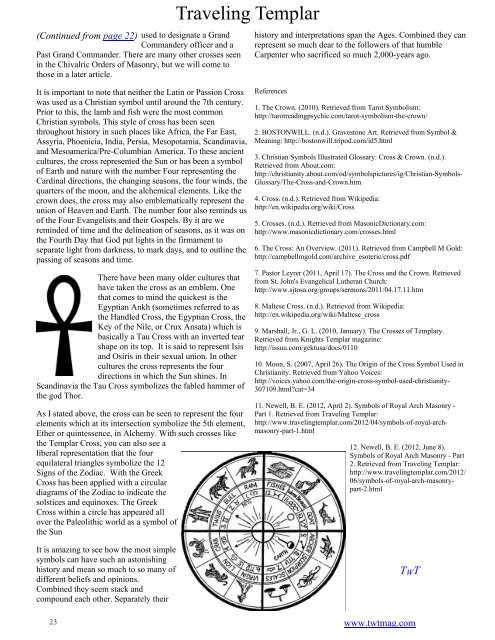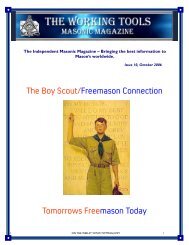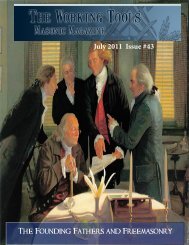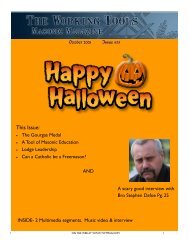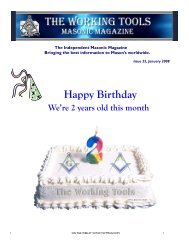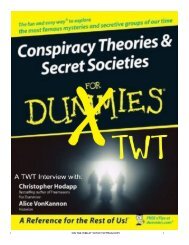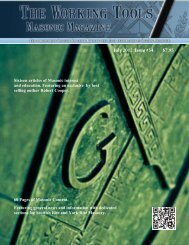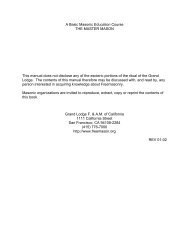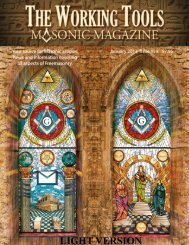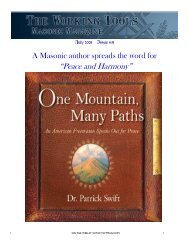The Working Tools Magazine âLightâ Version - Hawthorne-Fortitude ...
The Working Tools Magazine âLightâ Version - Hawthorne-Fortitude ...
The Working Tools Magazine âLightâ Version - Hawthorne-Fortitude ...
You also want an ePaper? Increase the reach of your titles
YUMPU automatically turns print PDFs into web optimized ePapers that Google loves.
(Continued from page 22) used to designate a Grand<br />
Commandery officer and a<br />
Past Grand Commander. <strong>The</strong>re are many other crosses seen<br />
in the Chivalric Orders of Masonry, but we will come to<br />
those in a later article.<br />
Traveling Templar<br />
history and interpretations span the Ages. Combined they can<br />
represent so much dear to the followers of that humble<br />
Carpenter who sacrificed so much 2,000-years ago.<br />
It is important to note that neither the Latin or Passion Cross<br />
was used as a Christian symbol until around the 7th century.<br />
Prior to this, the lamb and fish were the most common<br />
Christian symbols. This style of cross has been seen<br />
throughout history in such places like Africa, the Far East,<br />
Assyria, Phoenicia, India, Persia, Mesopotamia, Scandinavia,<br />
and Mesoamerica/Pre-Columbian America. To these ancient<br />
cultures, the cross represented the Sun or has been a symbol<br />
of Earth and nature with the number Four representing the<br />
Cardinal directions, the changing seasons, the four winds, the<br />
quarters of the moon, and the alchemical elements. Like the<br />
crown does, the cross may also emblematically represent the<br />
union of Heaven and Earth. <strong>The</strong> number four also reminds us<br />
of the Four Evangelists and their Gospels. By it are we<br />
reminded of time and the delineation of seasons, as it was on<br />
the Fourth Day that God put lights in the firmament to<br />
separate light from darkness, to mark days, and to outline the<br />
passing of seasons and time.<br />
<strong>The</strong>re have been many older cultures that<br />
have taken the cross as an emblem. One<br />
that comes to mind the quickest is the<br />
Egyptian Ankh (sometimes referred to as<br />
the Handled Cross, the Egyptian Cross, the<br />
Key of the Nile, or Crux Ansata) which is<br />
basically a Tau Cross with an inverted tear<br />
shape on its top. It is said to represent Isis<br />
and Osiris in their sexual union. In other<br />
cultures the cross represents the four<br />
directions in which the Sun shines. In<br />
Scandinavia the Tau Cross symbolizes the fabled hammer of<br />
the god Thor.<br />
As I stated above, the cross can be seen to represent the four<br />
elements which at its intersection symbolize the 5th element,<br />
Ether or quintessence, in Alchemy. With such crosses like<br />
the Templar Cross, you can also see a<br />
liberal representation that the four<br />
equilateral triangles symbolize the 12<br />
Signs of the Zodiac. With the Greek<br />
Cross has been applied with a circular<br />
diagrams of the Zodiac to indicate the<br />
solstices and equinoxes. <strong>The</strong> Greek<br />
Cross within a circle has appeared all<br />
over the Paleolithic world as a symbol of<br />
the Sun<br />
It is amazing to see how the most simple<br />
symbols can have such an astonishing<br />
history and mean so much to so many of<br />
different beliefs and opinions.<br />
Combined they seem stack and<br />
compound each other. Separately their<br />
References<br />
1. <strong>The</strong> Crown. (2010). Retrieved from Tarot Symbolism:<br />
http://tarotreadingpsychic.com/tarot-symbolism-the-crown/<br />
2. BOSTONWILL. (n.d.). Gravestone Art. Retrieved from Symbol &<br />
Meaning: http://bostonwill.tripod.com/id5.html<br />
3. Christian Symbols Illustrated Glossary: Cross & Crown. (n.d.).<br />
Retrieved from About.com:<br />
http://christianity.about.com/od/symbolspictures/ig/Christian-Symbols-<br />
Glossary/<strong>The</strong>-Cross-and-Crown.htm<br />
4. Cross. (n.d.). Retrieved from Wikipedia:<br />
http://en.wikipedia.org/wiki/Cross<br />
5. Crosses. (n.d.). Retrieved from MasonicDictionary.com:<br />
http://www.masonicdictionary.com/crosses.html<br />
6. <strong>The</strong> Cross: An Overview. (2011). Retrieved from Campbell M Gold:<br />
http://campbellmgold.com/archive_esoteric/cross.pdf<br />
7. Pastor Leyrer (2011, April 17). <strong>The</strong> Cross and the Crown. Retrieved<br />
from St. John's Evangelical Lutheran Church:<br />
http://www.sjtosa.org/groups/sermons/2011/04.17.11.htm<br />
8. Maltese Cross. (n.d.). Retrieved from Wikipedia:<br />
http://en.wikipedia.org/wiki/Maltese_cross<br />
9. Marshall, Jr., G. L. (2010, January). <strong>The</strong> Crosses of Templary.<br />
Retrieved from Knights Templar magazine:<br />
http://issuu.com/gektusa/docs/0110<br />
10. Moon, S. (2007, April 26). <strong>The</strong> Origin of the Cross Symbol Used in<br />
Christianity. Retrieved from Yahoo Voices:<br />
http://voices.yahoo.com/the-origin-cross-symbol-used-christianity-<br />
307109.html?cat=34<br />
11. Newell, B. E. (2012, April 2). Symbols of Royal Arch Masonry -<br />
Part 1. Retrieved from Traveling Templar:<br />
http://www.travelingtemplar.com/2012/04/symbols-of-royal-archmasonry-part-1.html<br />
T W T<br />
12. Newell, B. E. (2012, June 8).<br />
Symbols of Royal Arch Masonry - Part<br />
2. Retrieved from Traveling Templar:<br />
http://www.travelingtemplar.com/2012/<br />
06/symbols-of-royal-arch-masonrypart-2.html<br />
T W T<br />
23 www.twtmag.com


